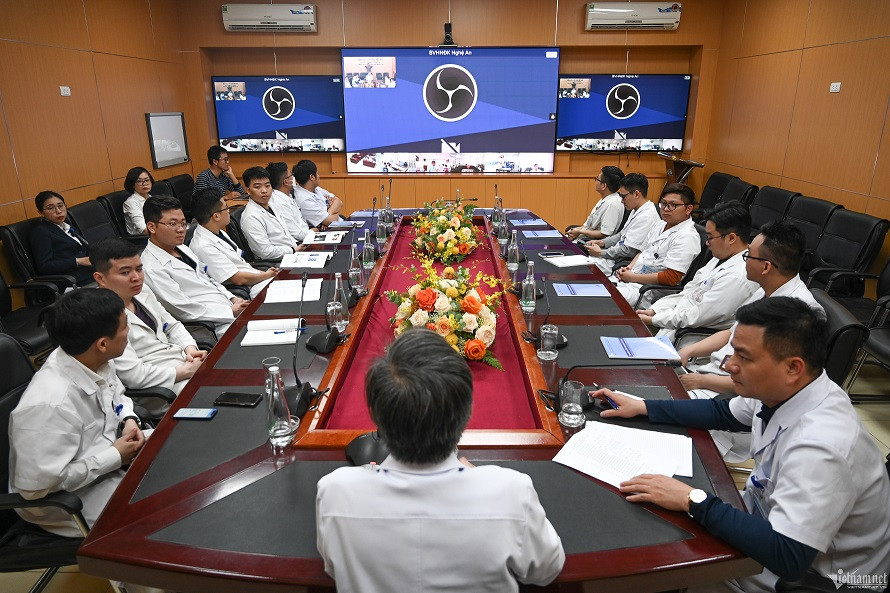
Innovation to enable people in remote areas enjoy quality medical services
The Party and state always affirm the role of grassroots healthcare as the foundation. Health sector leaders always consider grassroots healthcare (medical facilities at the district level and below) as the "springboard of the healthcare sector" from which to build "superstructure" works with the view of how to serve the people fastest. Therefore, innovating grassroots healthcare operations so that people can enjoy higher-level healthcare services right at the grassroots level is always the concern of the health sector. One of solutions to promote it is the remote medical examination and treatment.
It can be said that remote medical examination and treatment, in addition to keeping pace with the flow of digital transformation and information technology application in the 4.0 era, is also a humane solution to blur the gap and create equality in people's access to medical examination and treatment services.
Deputy Minister of Health Do Xuan Tuyen said that on June 22, 2020, the Ministry of Health issued Decision No. 2628/QD-BYT approving the Project "Remote medical examination and treatment" for the period 2020-2025, aiming that all people will receive management, consultation, medical examination and treatment, and professional support from doctors from the commune level to the central level; people can use quality medical services from higher levels right at lower level medical facilities.
Accordingly, lower-level medical facilities receive regular and extraordinary professional support from central hospitals based on information technology platforms. This helps reduce hospital overload, improving the quality and efficiency of medical examination and treatment and people's satisfaction.
Mr. Nguyen Truong Nam, Deputy Director of the Health Information Center, Ministry of Health, said that in September 2020, the Ministry of Health inaugurated 1,000 remote medical examination and treatment points. To date, nearly 2,000 Telehealth points have been connected from district-level medical facilities upwards.
From 24 higher level hospitals designated to participate in the remote medical examination and treatment network in June 2020, up to now, the number has increased to more than 100 nuclear hospitals. No longer limited by space in medical examination and treatment, and no people left behind is the big goal of this project. Along with that, it helps doctors and nurses in remote areas feel more secure and confident in treating seriously ill patients.
At the 2023 national online conference on healthcare work held in late February 2023, Prime Minister Pham Minh Chinh requested the health sector to drastically implement investment programs and projects to improve the capacity of the health system; Promote the application of information technology, improve the quality of human resources and information technology infrastructure to serve remote consulting and medical examination and treatment.
Recently, the Ministry of Health required all public hospitals to deploy a platform to support remote medical examination and treatment consultation (VTelehealth) in 2023, helping people access medical services easily and reduce the medical burden for central and provincial hospitals.
Commune doctors also join telehealth system
Not only district-level medical centers can participate in the network of remote consultations and medical examination and treatment, an initiative of the Ministry of Health and the United Nations Development Program (UNDP) called "Doctor for every home" also helps commune health stations join this remote medical examination and treatment network.
This application is installed on phones, tablets, computers..., to support capacity building for commune health station staff, so people can access good doctors at higher levels. Dr. Nguyen Trong Khoa, Deputy Director of the Department of Medical Examination and Treatment Management, Ministry of Health, said that applying technology to remote medical examination and treatment at the grassroot medical facilities opens up great opportunities for medical workers at the commune and district levels in connecting, improving training, sharing expertise, transferring techniques, narrowing the gap between upper and lower level doctors.
"This is an opportunity to create equality for all people to access medical examination and treatment facilities, especially qualified physicians," Mr. Khoa said.
Launched in 2020, in phase 2, the application is deployed in 5 provinces including Dak Lak, Thua Thien - Hue, Quang Ngai, Binh Dinh and Ca Mau, implemented at 1,403 medical facilities at provincial, district and commune levels, all of which are connected to the Ministry of Health's data center. Up to 755,000 accounts for people have been created, about 28,000 appointment requests have been booked through this system as of June 2023.
After more than 3 years of implementation, this solution has proven its effectiveness and is praised by not only local health officials but also people.
Mr. Khoa said that this application clearly demonstrates the role of digital transformation in promoting equality in access to health care, creating a closer connection between doctors and people, helping to improve uninterrupted health care; strengthening medical examination and treatment at the grassroot level for people in mountainous and remote areas, including ethnic areas and people with disabilities with the goal of "leaving no one behind".
Affirming that remote medical examination and treatment is very necessary, many leaders of "nuclear" hospitals in Hanoi shared their desire to connect remote consultation and examination and treatment with many more hospitals, especially those in remote areas, in order to promptly support cases of seriously ill and emergency patients who cannot endure long referral distances.
Officials of the Hanoi-based Viet Duc Hospital expressed their hope to be able to connect, unify, and securely share data between electronic medical record systems, operating rooms, testing systems, and imaging diagnostic storage systems of hospitals in Vietnam, to better serve medical examination and treatment and remote consultations, so that leading experts can support the grassroot medical facilities quickly and most accurately.
Minh An